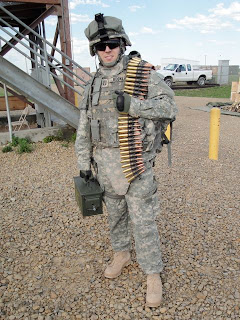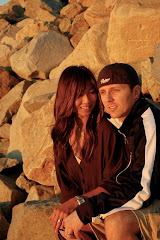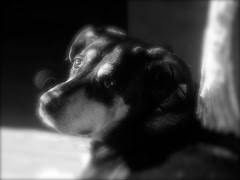Hi Everyone. Wednesday was a pretty light day...I think I was done by 1200. Therefore, I have elected to say very little about it; after all it's my blog and I can do what I want.
Sorry, I was feeling a bit sassy.
Thursday...RANGE DAY!!!! Let's shoot stuff!
Alright, here we go. Our day began at 0430. That's right, the infamous barracks lights dazzled us with their brilliance awfully early this morning. However, I think everyone was a little excited to make it to our first day on the range, so tolerance for the wake up call was certainly evident. That being said, I dug myself out of the Hooch (my bunk) and threw on my battle rattle and made my way out to the Hum-V. But, first thing's first...as you'll notice in the initial picture...coffee was necessary. Yum, love that cup o' Jo.
I don't believe I've described what our convoys, or more appropriately named "Mounted Combat Patrols" entail. It's quite the process. Prior to our team of 7 vehicles pulling out of the parking lot, we must ready our individual transports. And, in true military fashion, there is a checklist. With that, we comb over the vehicle, checking lights, oil, transmission fluid, brake fluid, dash panel measurements, and radios. Additionally, each vehicle has an oil drip pan under the engine and a chalk block that must be put away before traveling. There is more, but I'm sure you get the picture. As I said before, we have a team of 7 vehicles, broken down into 2 teams, "Blackbeard" and "Neptune". For those interested, the names are derived as a result of our Navy heritage. I am part of the Neptune crew.
(If I haven't mentioned this, we have approximately 25 Navy personnel and 4 Army personnel. The Navy contingency is wholly medical whereas our Army brethren are a logistics crew. Our Navy ranks range from E6 to Chief (enlisted) and LTJG to Commander (officer). There is a Major, Sergeant First Class and two Staff Sergeants in the Army crew.)
Having checked the boxes, we proceeded by convoy, 11 miles into the interior of Fort Riley where multiple firing ranges are organized into a circle...all firing to the center. Mind you, the radius of this range is many miles. Hopefully, that answers your questions in regards to worrying about the guy on the opposite side of the range firing in your direction. (I know I thought about it.) When we arrived at range 7 (0730), we all gathered in a bleacher area for a safety briefing. There were a total of 80-90 participants in this exercise, 25 Navy, 4 Army and 50-60 Air Force.
After the briefing, we meandered down to the ammunition stockpile at the base of the observation tower in the above picture, gathered one .50 Cal belt (50 rounds...one round = one bullet) and another box containing a 100 round belt. Andrew (the Internist and Critical Care doc) was my battle buddy for the day. Essentially, we were always paired for our time on range. Andrew also knows a bit more than I do about weapons, so he helped me throughout our qualifications on each weapon.
Lookin' tough...as usual.
Total of 150 rounds of .50 Cal ammo.
Dat's a whole lot'a ammo...all .50 Cal rounds.
As you can see, we all stood in a line awaiting our turn to occupy one of ten Hum-V's with a .50 Cal gun mounted in the gun turret. Since Andrew and I weren't in the first group, as we stood by, it became painfully evident that our ear protection, affectionately called "ear pro", was most necessary. These weapons fire with a rather emphatic "pop"...kinda gets your adrenaline going.

Finally it was our turn. I decided to go first and from the minute I crawled onto the Hum-V and lowered myself down into the turret, I felt as though I just consumed 5 shots of espresso, a six-pack of Mountain Dew and washed it all down with a Red Bull...apparently it gives you wings???? In other words, I was mildly excited.
While I would assume most of you have not been inside of a Hum-V turret, it's a lot like a round sun roof, but you stand on the middle console. Also, it's not as comfortable standing in this hole and trying to brace yourself while you line up your shot and prepare for the "kick-back" of the weapon. But, this is not suppose to be your living room Lazy Boy recliner either. You can swivel the turret from side to side and lock it in place as you see fit.
Now, after I settled in, the instructor (a contract worker who was a former infantryman in the Army) acquainted me with the weapon and what they call the T & E. The "T" stands for traverse (meaning side to side movement) and the "E" stands for elevation (self explanatory). Traversing was accomplished with the turret swivel, while elevation was altered up or down with a wheel knob located under the weapon (see my left hand in the picture above...it's on the elevation knob) With such a large weapon, one needs these movements to adjust the weapon for proper sight pictures. A "sight picture" is the picture of the target one sees through the weapon sights as one lines up the shot.
Below is a picture of the range. The mounds of dirt are set at different distances. On the right side, you may notice to two dark posts just to the left of the "3-4" sign. It is one of the targets that pops up and down throughout the qualification. That particular target is located at 600 meters (1800 feet). The remaining targets for the .50 Cal are located at 400, 500, 700, 800, and 1000 meters (multiply meters times 3 to get the distance in feet). Shooting at the 1000 meter target is over a half mile away...not a close shot.
Several times I have mentioned "qualification". For each weapon we fire, we are tasked with hitting a certain number of targets over a period of time. The .50 Cal, requires hitting 7 out of 10 targets over the course of 13 minutes to qualify. The targets initially pop up one at a time (one at each distance, for total of 6) and then two at a time (for the remaining 4 targets). Our 2 Navy-Army teams needed a minimum of 8 out of 29 people to qualify for our group to move on. Everyone on our teams did well and many qualified. I was lucky and hit 8/10. I give a lot of credit to my instructor who was helping me line up my shots by telling me "right...left...up 1...down 2".
Now, shooting the weapon is completely different than I anticipated. You don't hold the weapon like a normal rifle, or pull the trigger in the same way. Instead, you hold two vertical handles on the end of the gun and use your thumbs to depress the trigger. Admittedly, I thought there would be a huge "kick" with each shot, but the mounting mitigates the recoil for the most part. Sheepishly though, I think I closed my eyes the first few times. (Please check out the video at the bottom of this blog to see me shooting the .50 Cal.) I know I said earlier in my blogging that the Hum-V driving day was the best, but in the first few hours of this day...WAY COOLER!
JC "Major Christenson" and I hanging out, awaiting our turn.
Exhausted from the excitement and .50 Cal qualification, we all took a little break in the bunker where a couple of the Army junior enlisted were selling hot dogs, chips and sodas...and Hostess cream-filled cakes. We were able to take our battle rattle off in this bunker, which was heaven.
Following the .50 Cal qualification, we essentially went through the same motions and fired both the 240 Bravo and 249 SAW. I think we were given 200 rounds a piece for these weapons. For the "Gun Club" aficionados, the 240 Bravo shoots a 7.62 millimeter round and the 249 SAW shoots a 5.56 mm round. Below, you can see the 240 Bravo.

It looks and feels more like a conventional gun with a butt stock and trigger where my right hand is. This was a more difficult weapon to shoot...for me. While the .50 Cal was more stable and heavy, this weapon was a bit "squirrely". The recoil after firing wasn't bad at all, but because the gun is so much more mobile in the turret, it moves easily after each round is fired. The 249 SAW was even smaller and characteristically the same. In regards to the targets for both of these weapons, I believe the 240 Bravo targets were from 200 to 800 meters and the 249 SAW targets were from 100 to 600 meters. Qualification on both of these weapons was either 6 or 7 out to 10 targets...sadly, I didn't get either. I think I only hit 5 targets on the 240 B and 4 targets on the 249 SAW. That was a tough pill to swallow. But, the remainder of our team did well and enough people qualified.

This was the target range for the 240 Bravo. Again, you can see the dark posts, shaped like people, on the mounds in the distance.
Here I am taking a little afternoon break in the parking lot. It was hot and I was a bit tired from lugging that battle rattle around all day.
After all the Navy, Army and Air Force teams finished shooting all three weapons, we were allowed to make our way back to Camp Funston and grab some chow before the night shoot. One would think this shouldn't be too hard...just drive the vehicle back down the same road you came on in the morning. Well...let me elaborate for a few sentences on how that went. All 7 vehicles moved out and before you knew it, we were on a different road than what we came in on. Fortunately, it was simply a dirt road paralleling the paved road. But, I felt as though it was taunting us the whole way, because we couldn't go as fast. Adding insult to injury, the Air Force Hum-V's were on the paved road and passed us at an alarming rate...rats. When we finally made it onto the paved road, we missed one of the turns...SH&T!!! So, we made a "U" turn in the middle of the road and proceeded in the correct direction. However, we weren't done yet. Not more than 5 minutes into the drive, one of our vehicles "smelled something burning". Double SH%T!!! So, we pulled to the side of the road, ditched the defunked Hum-V, loaded the orphans into a flat-bed Hum-V like illegal aliens on a farm, and drove back to the barracks. All in all, it took us at least twice as long to get to base as it should have...oh good fun (this is sarcasm). It had already been a long day, but we were just getting started...
Bellies full and minds fraught with anticipation for the night shoot, we convoyed back up to range 7. Following another safety brief, we lined up to gather more ammunition for the .50 Cal shoot. The sun didn't actually go down until about 2000, but we had to wait for the sky to become dark enough to make the shoot worth while. By 2130, it was on. We didn't use Night Vision Goggles (NVG) for this; instead, we used a night optic device called a PAS 13 Thermal Weapon Sight. This kicks butt. Since a normal NVG uses some ambient light to distinguish images, we would have required some light source down range either on or from the target to detect them. In the case of the PAS 13, the targets were illuminated by the emitting thermal energy (a heater) like a human being or a hot gun barrel. Down range, the targets light up bright green, or black, depending on your setting. Then, it was pretty much the same techniques as the daytime shoot. We used the same optics for the 240 Bravo as well. (There was no 249 SAW shoot this evening.)
As a Navy-Army crew, we all shot well and moved through our range shoot pretty quickly, however, the Air Force had more people and required more people to qualify on the .50 Cal at night. They weren't doing so hot. So, by 2300, most of our group sought shelter and rest (as seen below). I couldn't sleep, but I did take my battle rattle off...soooo much better.
Well, the Air Force finished their .50 Cal shoot by about 0000. Thus, onto the 240 Bravo. Yes, we still needed to complete that shoot. Longer story made shorter, we concluded shooting around 0330. After "policing brass", which means, "now that you've shot all these rounds...go pick up the brass casings", we loaded up the Hum-V's and set out for home. All I know is that my watch said 0500 by the time I took a shower and crawled back into the "Hooch" for a quick nap...
To Be Continued...








.jpg)






No comments:
Post a Comment